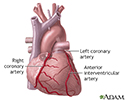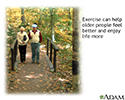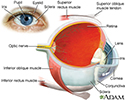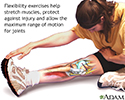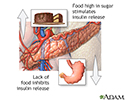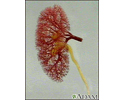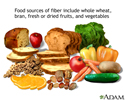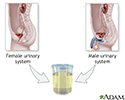Multimedia Gallery
Stroke
A stroke can occur when an obstruction such as a blood clot travels from another part of the body and lodges inside an artery in the brain.
When an arterial wall becomes damaged, various types of emboli, or obstructions, can form. Emboli can be made up of various substances such as platelets, elements in the blood that help it clot, blood clots that form elsewhere and pass to the damaged area, cholesterol, or a combination of things.
For example, an embolism is formed in the carotid artery and breaks loose, traveling towards the brain where it will eventually lodge, blocking the blood the brain needs. The blocked artery deprives the brain of oxygen, which cause damage to the surrounding tissue. The result is a stroke.
Stroke
Review Date: 4/16/2025
Reviewed By: Joseph V. Campellone, MD, Department of Neurology, Cooper Medical School at Rowan University, Camden, NJ. Review provided by VeriMed Healthcare Network. Also reviewed by David C. Dugdale, MD, Medical Director, Brenda Conaway, Editorial Director, and the A.D.A.M. Editorial team.
Animations
- Blood pressure
- Bunion
- Cataract
- Childhood obesity
- Cholesterol and triglycerid...
- Coronary artery disease
- Depression
- Diabetes
- Diabetes - retinal conditions
- Diabetes and risk of seriou...
- Dialysis
- Erection problems
- Exercise
- Foot pain
- Gallstones
- Glaucoma
- Hardening of arteries
- HbA1c
- Healthy Guide to Fast Food
- Heart attack
- Hypertension
- Hypertension - overview
- Immune response
- Smoking
- Smoking tips to quit
- Stroke
- Stroke
- The goals of proper type 2 ...
- Tobacco use - effects on ar...
- Tracking your blood pressur...
- Type 1 diabetes
- Type 2 diabetes
- Understanding cholesterol r...
- Urinary incontinence
- Urinary tract infection - adults
- Vaccines
- Venous insufficiency
Illustrations
- 15/15 rule
- Abdominal girth measurement
- Abdominal muscles
- Acanthosis nigricans - close-up
- Acanthosis nigricans on the hand
- Acute MI
- Adjustable gastric banding
- Aerobic exercise
- Alpha-glucosidase inhibitors
- Angina
- Anterior heart arteries
- Atherosclerosis of the extr...
- Autonomic Nerves
- Baby bottle tooth decay
- Benefit of regular exercise
- Biguanides
- Blood pressure
- Blood pressure check
- Blood test
- Blood test
- Brain
- Brainstem function
- Calculating body frame size
- Candida - fluorescent stain
- Candidiasis, cutaneous - ar...
- Carotid dissection
- Carotid stenosis - X-ray of...
- Carpal tunnel syndrome
- Cataract - close-up of the eye
- Central nervous system
- Central nervous system and ...
- Cerebellum - function
- Childhood obesity
- Children's diets
- Cholesterol
- Cholesterol producers
- Circle of Willis
- Circulation of blood throug...
- Complex carbohydrates
- Coronary artery blockage
- Coronary artery disease
- Creatinine tests
- DASH diet
- Dermatitis - reaction to tinea
- Dermatitis - stasis on the leg
- Developmental process of at...
- Diabetes and exercise
- Diabetes and nerve damage
- Diabetes risk factors
- Diabetic blood circulation ...
- Diabetic emergency supplies
- Diabetic foot care
- Diabetic foot care
- Diabetic nephropathy
- Diabetic retinopathy
- Different types of weight gain
- Digestive system
- Endarterectomy
- Endocrine glands
- Energy levels
- Exercise - a powerful tool
- Exercise 30 minutes a day
- Exercise and age
- Exercise and heart rate
- Exercise can lower blood pr...
- Exercise with friends
- Eye
- Fast food
- Fasting plasma glucose test
- Female reproductive anatomy
- Female urinary tract
- Femoral nerve damage
- Fish in diet
- Flexibility exercise
- Follicle development
- Folliculitis - decalvans on...
- Folliculitis on the leg
- Food and insulin release
- Food label guide for candy
- Food label guide for whole ...
- Foot swelling
- Fruits and vegetables
- Fungus
- Gestational diabetes
- Gingivitis
- Gingivitis
- Glaucoma
- Glucose in blood
- Glucose test
- Granuloma - fungal (Majocchi's)
- Granuloma - fungal (Majocchi's)
- Granuloma annulare - close-up
- Granuloma annulare on the elbow
- Granuloma annulare on the eyelid
- Granuloma annulare on the legs
- Hair follicle anatomy
- Hammer toe
- Healthy diet
- Healthy diet
- Heart - front view
- Heart - section through the...
- Heart attack symptoms
- High blood pressure tests
- Influenza
- Influenza vaccines
- Ingrown toenail
- Insulin production and diabetes
- Insulin pump
- Insulin pump
- Islets of Langerhans
- Isometric exercise
- Jaw pain and heart attacks
- Kidney - blood and urine flow
- Kidney anatomy
- Kidneys
- Left cerebral hemisphere - ...
- Lifestyle changes
- Lipocytes (fat cells)
- Low blood sugar symptoms
- Male urinary system
- Male urinary tract
- Monitoring blood pressure
- myPlate
- Nail infection - candidal
- Necrobiosis lipoidica diabe...
- Necrobiosis lipoidica diabe...
- Nervous system
- Nervous system
- Normal uterine anatomy (cut...
- Obesity and health
- Omega-3 fatty acids
- Oral glucose tolerance test
- Osmolality test
- Pancreas
- Pancreas and kidneys
- Pelvic laparoscopy
- Pesticides and fruit
- Pharmacy options
- Physical activity - prevent...
- Pituitary and TSH
- Plaque buildup in arteries
- Pneumococcal vaccine
- Post myocardial infarction ...
- Posterior heart arteries
- Prevention of heart disease
- Progressive build-up of pla...
- Proteins
- Quitting smoking
- Radial nerve dysfunction
- Read food labels
- Retinal dye injection
- Right cerebral hemisphere -...
- Ringworm - tinea corporis o...
- Ringworm - tinea corporis o...
- Ringworm - tinea manuum on ...
- Ringworm - tinea on the han...
- Ringworm of the scalp
- Ringworm, tinea capitis - c...
- Roux-en-Y stomach surgery f...
- Salad nutrients
- Saturated fats
- Secondary infection
- Simple carbohydrates
- Slit-lamp exam
- Smoking hazards
- Sources of fiber
- Soy
- Stable angina
- Starchy foods
- Stein-Leventhal syndrome
- Stomach
- Stomach disease or trauma
- Stye
- Sulfonylureas drug
- Surface anatomy - normal palm
- Surface anatomy - normal wrist
- Swollen gums
- Thiazolidinediones
- Thyroid uptake test
- Tinea corporis - ear
- Tinea versicolor - close-up
- Tinea versicolor - close-up
- Tinea versicolor - shoulders
- Tinea versicolor on the back
- Tooth anatomy
- Tooth anatomy
- Trans fatty acids
- Type I diabetes
- Ulnar nerve damage
- Untreated hypertension
- Urine sample
- Uterus
- Vaginal discharge
- Visual field test
- Vitiligo
- Vitiligo - drug induced
- Vitiligo on the back and arm
- Vitiligo on the face
- Weight loss
- White nail syndrome
- Wood's lamp test - of the scalp
- Wrist anatomy
- Xerosis - close-up
- Yeast and mold
- Yeast infections
- Yoga
- Yo-yo dieting

 Bookmark
Bookmark















































